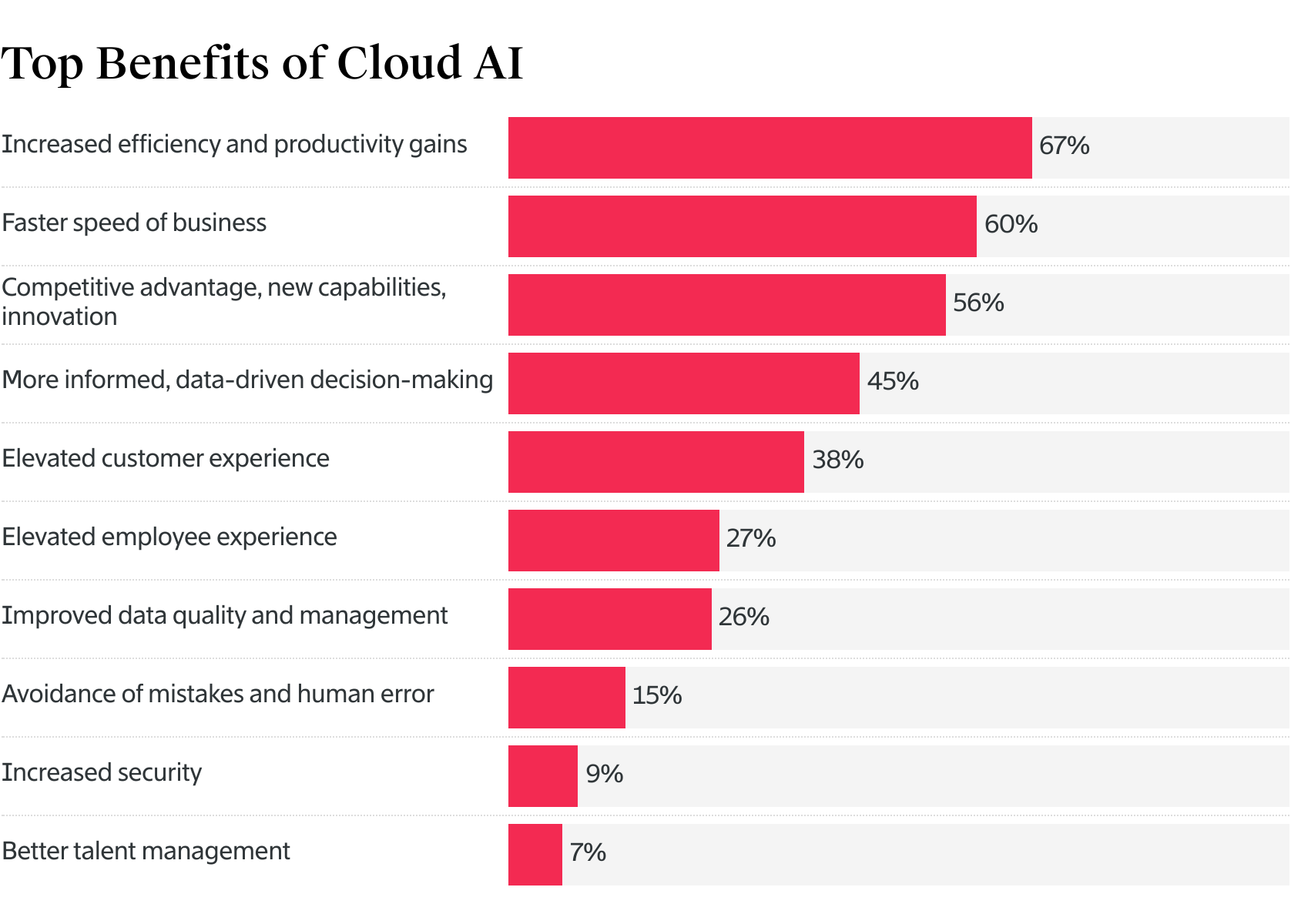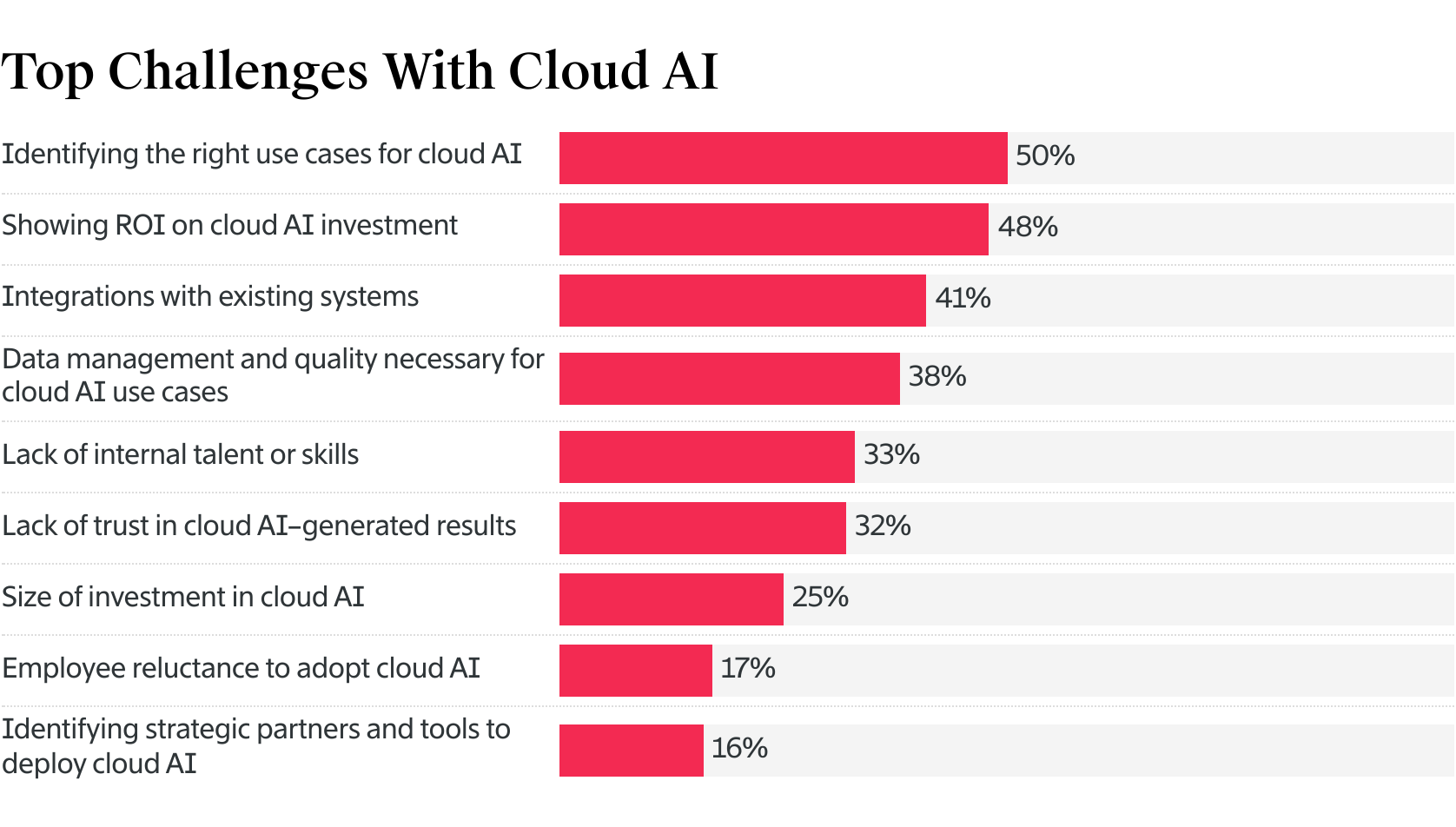How Ready Are You for the Next Phase of Cloud AI?

Inexorable, overhyped, underappreciated: These are the seemingly mutually exclusive adjectives The Information’s readers use to describe cloud artificial intelligence in a recent survey (see methodology). The reason for these divergent opinions is the relatively early stage of cloud AI deployment, where success in cloud AI has not yet been fully defined, and the winners and losers have not yet emerged.
Most of The Information’s 121 survey participants are still in the early stage in terms of understanding what cloud AI can do, but they are directing significant investment to it. That’s because they believe success at cloud AI is a must for companies to succeed.

This article will identify our readers’ perceived benefits of implementing cloud AI solutions and dive deeper into how they are realizing business value from different types of AI. It will also explore the challenges companies are facing in deploying and truly benefiting from cloud AI to drive growth and innovation.
Top Benefits: Beyond Speed and Efficiency
The Information’s readers admit that it is early days for cloud AI in an enterprise. “I’m still trying to understand how to use it strategically, beyond simplistic use cases,” says one reader. Another reader is more thumbs-down: “Way too much hype. I’ve dealt with AI bots on apps and have been hugely unimpressed. I end up needing to talk to an actual human to fix a legitimate issue.”
Sums up another reader: “We will embrace Al if and when its use and benefits are determined to be of value to my business goals.”

The top benefits of cloud AI have to do with efficiency, productivity and speed. But it also offers benefits such as competitive advantage and innovation, which can lead to a disruption of industries via the transformation of business models or the introduction of new product lines.
The least recognized benefit is using AI for better talent management, with just 7% of The Information’s readers pointing to that usage. And just about a quarter (27%) of readers see AI as a way to elevate employee experience. These responses fell in line with a tendency to not fully appreciate the role of talent in AI’s success.
One reader points to this blind spot at the intersection of technology and people: “Deploying an AI app or agent is relatively straightforward. The crux is the last mile of the effort. The hardest part is herding everyone that touches a process or workflow, getting them to engage enthusiastically and desire change.”
Another reader describes the current state of AI adoption as follows: “I found that most clients are very disjointed at a leadership level about when and how to adopt AI, and [are not sure about] the return on investment. There’s a lot of hesitancy to go for fully fledged programs to assess where AI can improve productivity in innovation and unlock growth.” The reader adds that to get to a comprehensive and high-level AI vision, “more organizations need access to reliable and trustworthy advice about the security of cloud services on the public cloud.” It boils down to the issue of having an AI partner with the right answers.
Cloud AI: Catalyst for Operational Excellence, Growth and Innovation
For The Information’s readers, using cloud AI is a given. Eighty-six percent say they are planning to or have deployed cloud AI or are realizing business value from it (see chart: “Deploying AI”). “All reasonable applications of AI require the cloud for all but the most secretive organizations,” says one of The Information’s readers. “For everyone else, the ability to be on state-of-the-art infrastructure solving a problem that is not yet well understood requires the cloud.”
The question among The Information’s readers is not whether to use cloud AI but whether to go with an all-public cloud solution or adopt a hybrid approach. “Cloud AI is inexorable for adequate performance,” says a hospital executive. “Cloud AI is just one mechanism to deploy AI solutions. A hybrid solution is most likely in the future coupled with smaller use-case–specific models.” For a hospital, for instance, keeping control of sensitive information on the premises makes sense and adds extra security. Such an organization can also help optimize costs by running intensive AI tasks that involve less critical data on the public cloud, allowing for efficient resource allocation.

Cloud AI catalyzes growth by increasing productivity, efficiency and speed, as well as by boosting innovation and competitive advantage (see chart: “Top Benefits of Cloud AI”).
According to a McKinsey analysis, artificial intelligence can save up to 40% of operating costs. Leading distributors are using AI to create more efficient, agile and streamlined supply chains and support functions. New tools and approaches are emerging across the distribution value chain, in planning, warehousing, transportation and the way distributors develop and retain talent.
Among SAP customers, Chobani, an American food company, achieved a 75% reduction in time spent on expenses, and ZF Friedrichshafen, a German technology manufacturing company, speeded up its forecasting in operational and demand planning by 92%. In procurement, category managers using SAP’s AI-driven tools can jump-start their category plans by applying market dynamics and cost structure insights. They experience up to 56% reduced onboarding time, 70% more category coverage and 2.3 times realized cost savings.
Innovation based on cloud AI boosts competitive advantage across multiple industries. For example, cloud AI solutions to optimize solar energy storage and smart home energy distribution improve energy efficiency and grid independence. AI-powered autonomous driving is revolutionizing the transportation industry, and the use of AI for precision farming is positively impacting the environment and food supply.
Such operational excellence and disruptive transformation of whole industries could not happen without cloud AI. Underlying the innovation it is driving across multiple industries is the innovation within AI technology itself. One reader of The Information points to continual upgrades in hardware as the reason to rely on cloud AI. “It’s impossible to stay agile without cloud AI, even when you have your own models. The rate of change in hardware is still so high that you need the scale of the cloud to stay competitive,” says the reader.
Top Challenges: The Importance of the Right Partner and Good Data
The Information’s readers recognize cloud AI as the primary way to deploy AI, but it comes with caveats. The list of challenges is long, and it’s topped by the difficulties of identifying the right use cases for cloud AI and showing its return on investment and integrations with existing systems (see chart: “Top Challenges With Cloud AI”).

Interestingly, identifying the right strategic partners or tools to deploy cloud AI does not loom as a big challenge, with just 16% of the readers pointing to it. But having the right partner may in fact be the best way to solve all the other challenges.
A separate survey of 60 of The Information’s readers revealed that many companies are not satisfied with their current cloud vendors. Less than a third (30%) say their vendor helps them with integration of cloud AI with existing systems (30%) and showing ROI on cloud AI investments (29%). Less than a fifth (20%) say their vendor helps them with harmonizing all data to derive values with AI.
Data management came up among the top challenges to achieving trustworthy business outcomes with AI tools (38%). That’s because in many companies, internal data are not easily accessible, sit in siloed databases, and may be inconsistent or inaccurate. Combing through and integrating that information with external data brings in another level of complexity. Such issues with data are among the main reasons why people often do not trust machine-generated outcomes (32%).
Data management should be a top priority for any company deploying AI cloud solutions. When adding The Information’s survey respondents who point to data management (38%) and those who see lack of trust in AI-generated results (32%) as challenges to cloud AI, the total group accounts for 70% of the whole survey sample, making data the No. 1 concern by far. Sums up one of The Information’s readers: “There is no AI of quality without quality of data and a unique source of truth in companies, and we are still far away from that in small to large companies.”
CONCLUSION
The Information’s survey shows that cloud AI is a given as companies need the scale of cloud AI to stay competitive. The success of cloud AI depends on making the right choices in deploying it to create value. Top findings from the survey include:
- The success of cloud AI comes from bridging the gap between the value businesses provide their customers and understanding how specific cloud AI use cases can increase that value. Moving to the next stage of cloud AI entails education and expert consulting to find that ROI and implement it.
- Selecting the right cloud AI partner is key. The right partner has experience working with multiple organizations, running their most critical business processes and commitment to helping companies deliver business outcomes.
- High-quality, relevant data is necessary for achieving trust in cloud AI driven outcomes. The use of such data, whether from within an organization or from third parties, is critical to getting the most out of AI cloud applications in terms of trust, adoption, outcomes and ROI.
METHODOLOGY
This article is based on a survey of 121 readers of The Information conducted in January 2025. The survey respondents came from companies of different sizes and multiple industries, functional areas and corporate ranks:
Company size: Forty-one percent had revenues under $10 million; 28% had revenues of more than $1 billion; 16% had revenues between $10 million and $100 million; 8% had revenues of $100 million to $500 million; and 7% had revenues of $500 million to $1 billion.
Industry: The biggest group of respondents came from technology media and communications (48%), followed by professional services (16%) and the financial sector (9%). The remainder represented healthcare and life sciences, government and public sector, retail and others.
Functional area: The biggest group of respondents came from general management (31%), followed by technology (23%), research and development (14%), sales (8%), marketing and communications (7%), finance (7%) and others.
Rank: The biggest group of respondents were directors (24%), followed by CEOs (12%), chief information officers and chief technology officers (12%), CEO-owners (11%), managers (11%), senior vice presidents and vice presidents (9%), owners (7%) and others.